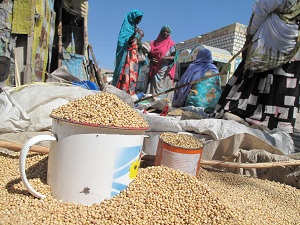FSNAU releases Market Update for February 2011
Issued: March 24, 2011
 The Somali Consumer Price Index (CPI), which measures changes in prices of a fixed minimum basket of goods and services, maintained its upward trend for the fifth month in succession in all regions in February 2011. Month on month inflation increased in all zones, mainly due to the rising prices of sorghum, sugar and milk (Northeast – 9%, Northwest – 6%, South – 5% and Central –2%). In SoSh areas, the CPI is 151-173 percent above the reference period (March 2007) while it is only 14 percent higher in the SlSh areas.
The Somali Consumer Price Index (CPI), which measures changes in prices of a fixed minimum basket of goods and services, maintained its upward trend for the fifth month in succession in all regions in February 2011. Month on month inflation increased in all zones, mainly due to the rising prices of sorghum, sugar and milk (Northeast – 9%, Northwest – 6%, South – 5% and Central –2%). In SoSh areas, the CPI is 151-173 percent above the reference period (March 2007) while it is only 14 percent higher in the SlSh areas.
The prices of locally produced cereals (maize and red sorghum) continued escalating in most areas as a result of the poor seasonal harvest in the South and increased demand. In February 2011, the red sorghum prices sustained an upward trend in the consuming regions of Northeast (17%) and Central (4%) as well as producing regions of Sorghum Belt (15%). In the same period, the average price of maize in Shabelle region surged by about 22 percent, while remaining stable in Juba due to the anticipated off-season maize production (March). Compared to a year ago, the local cereal prices are considerably higher both for maize (40-51%) and sorghum (80%) in the respective producing southern regions (Juba, Shabelle and Sorghum Belt). Sorghum prices have also risen in Central and Northeast, which receive the supplies of this cereal from the South. However, in Northeast the annual increase in sorghum price was relatively slower (26%) than in Central (54%) due to better access by various humanitarian agencies. The highest yearly increase in local cereal prices, however, was observed in Banadir region (sorghum - 165% and maize - 65%), reflecting the current crisis in surrounding rural livelihoods combined with volatile security situation in the region. Conversely, in Northwest the locally produced cereal price trends are favourable for consumers due to the bumper Gu/Karan 2010 cereal production in the zone, which brought yellow maize prices down by 28 percent, and kept white sorghum prices stable compared to last year (Feb. ‘10).
Prices of imported commodities such as petrol, rice and wheat flour remained constant in February in all regions apart from North SlSh areas, where they declined moderately from January 2011. Sugar and vegetable oil prices were also stable in most regions in February although slight to moderate monthly increases (4-12%) were seen in parts of the North and Central as well as in Banadir region in the South. When compared to the same month last year, the prices of most monitored import commodities, except rice, have increased moderately throughout Somalia, mainly due to soaring international commodity prices. The highest annual price increases for all imported commodities are observed in Banadir region.
With increasing cereal prices, a downward trend in the relative purchasing power that began in October 2010 continued into February 2011. The terms of trade (ToT) between daily labour wage and local cereals showed moderate decreases from January 2011 in all southern regions (9-21%). In other parts of Somalia that commonly rely on imported rice for consumption, the ToT was stable (North SoSh areas, Central) or improved moderately (North SlSh areas). Compared to a year ago, significant decline in the ToT is observed in southern regions of Shabelle (27%), Juba (47%) and Sorghum Belt (39%). The amount of cereals that can be exchanged for one day of labour ranges from as low as 3kg in Central to the highest terms of 7kg in the Sorghum Belt.
Exchange rate between USD to SoSh and SlSh remained relatively stable in February 2011 in most parts of Somalia. However, compared to the same month last year, the Somaliland Shilling appreciated by a significant 15 percent, while SoSh remained stable. The appreciation of the SlSh to the dollar is attributed mainly to increased foreign exchange earnings from livestock exports during the Hajj period as well as from the remittances from diaspora combined with general macro-economic stability in the region.

















